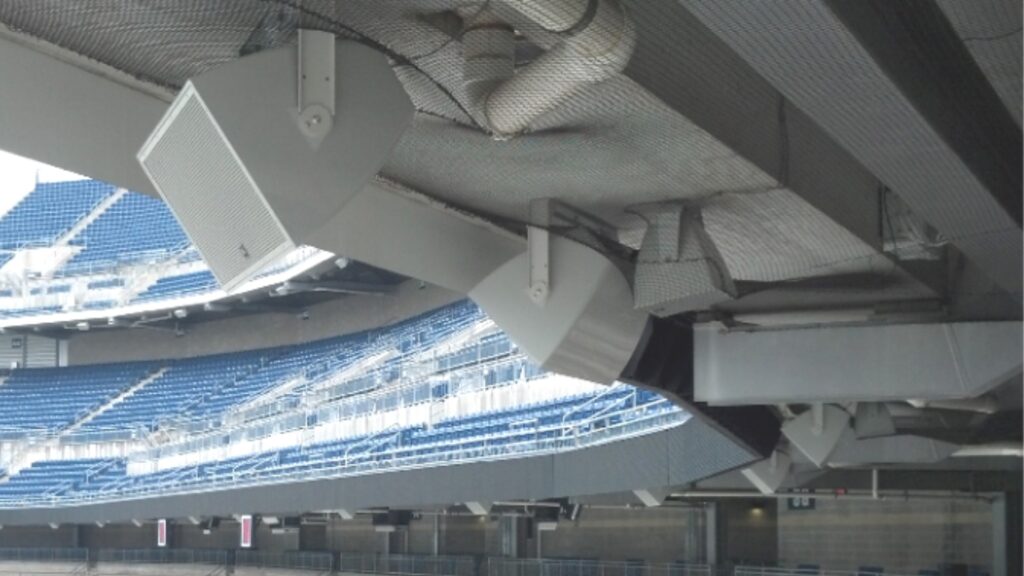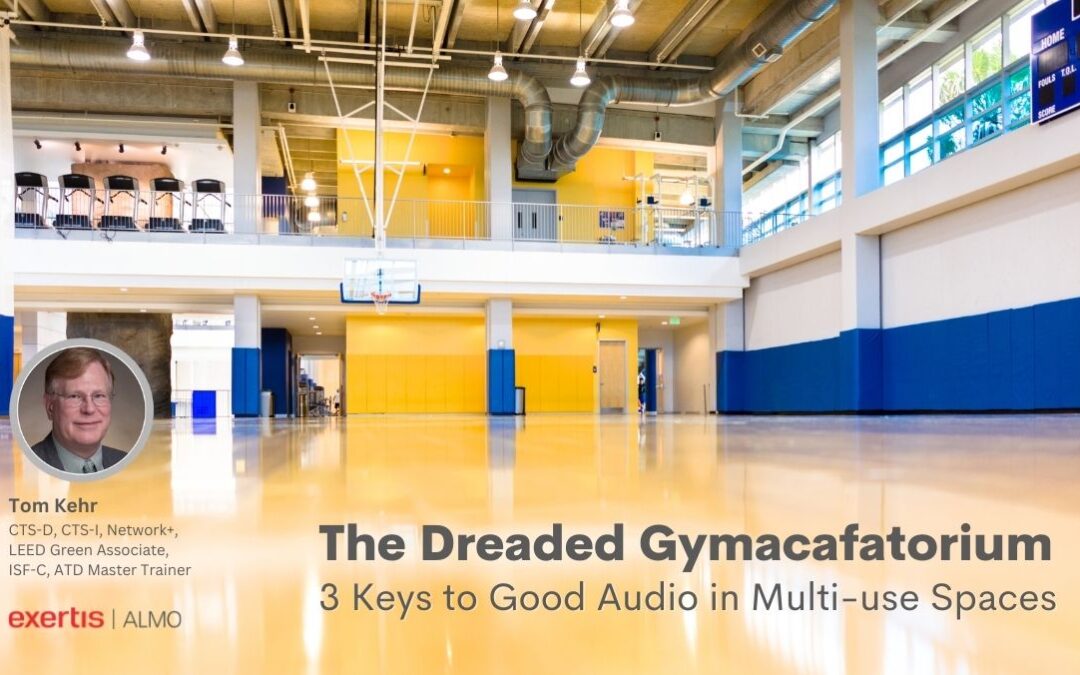What is a Gyma-cafa-torium?
The “multipurpose space.” It’s the room that’s intended for everything but does not do any one thing well, and it’s the bane of audio system designers around the globe.
Your client has come to you asking for a sound reinforcement system in one of these “gymacafatoriums.” But first, let’s start with an etymology lesson:

💡 auditorium (n.):
“part of a public building where people gather to hear speeches, etc.,” 1727, from Latin auditorium “a lecture-room,” literally “place where something is heard,” in Medieval Latin, especially “a reception room in a monastery,” noun use of neuter of auditorius (adj.) “of or for hearing,” from auditus, past participle of audire “to hear.”
From this lengthy definition, it seems that being able to hear is pretty important.
Normally, we think of an auditorium as some sort of rectangular box with fixed seating and a stage or platform at one end, but if it’s a “place where something is heard,” the infamous gymacafatorium is really an auditorium, regardless of the sign placed above the entrance.
If people need to be able to communicate in a space, doesn’t that really make every space an auditorium, by definition? If you can’t hear the audio content, you’re not communicating.
3 Keys to Auditorium Audio Design
There are three components when making an auditorium function as a place where something is heard:
These are the physical and acoustical properties of the space. This involves the size, shape, and the absorptive, reflective, and transmissive properties of the floor, walls, ceiling, and any other materials in the space. Think of absorption, reflection, and transmission as a triangle. The sum of the degrees of a triangle always equals 180, and it is the same principle with sound energy in a space. If it’s not absorbed, it’s reflected. What’s not absorbed or reflected is transmitted into an adjoining space.
The shape of the space is also a consideration. Avoid domes and curved walls, as these will focus sound energy in undesirable ways.
If the space also functions as a gym, it’s typically a bigger room with a high ceiling. Normally, it will have hardwood floors, painted CMU (concrete masonry units or “cinder block”), and some sort of steel ceiling. The result is little in the way of energy absorption, thus providing for lots of reflective energy. Even if they have wall pads, they aren’t of much help for absorption.
If it’s just a cafatorium, your ceilings may be 10 feet or so. These rooms typically have tile floors, painted CMU or gypsum walls, perhaps large windows, hopefully with acoustical drop tiles. Even with acoustically absorptive drop tiles, that’s absorption on only one of the six sides of the box, so these are typically noisy spaces as well. The low ceiling may limit you to using ceiling loudspeakers.
As the late John Murray still reminds us with Don Davis before him, “the only thing you can EQ is the loudspeaker.” In other words, the electronic adjustments performed during the equalization process can only affect the response of the loudspeaker. Once the sound leaves the loudspeaker, it’s out in the wild. The room itself, the room acoustics, will imprint its signature on the sound before it arrives to the listener. You can’t do anything about what happens to the sound between the loudspeaker and the listener unless you change the acoustical characteristics of the space.
Engaging a qualified acoustician at the beginning of any project of significance can help you design great sounding spaces. Many years ago, there were some commercials related to car maintenance that used the line, “Pay me now or pay me later.” It’s also true of the acoustician. The trouble here is that hiring the acoustician after everything has been built usually comes after a number of equipment upgrades that were intended to “fix the sound.” Additionally, implementing acoustic treatments after building completion tends to be a whole lot more expensive. Including the acoustician as part of the initial building design team can be a very economical decision.
All too often in the gymacafatorium, the HVAC system is way too noisy. After all, it was designed to be a gym, right? Reducing background noise levels to acceptable limits can be costly if the HVAC system requires a major refit or replacement to something that’s acceptable. There are easy ways to measure the current background noise levels for an initial assessment.
ASHRAE, the American Society of Heating, Refrigeration, and Air-Conditioning Engineers, has a chapter in their reference works entitled Sound & Vibration. It’s a great little chapter and includes Design Guidelines for HVAC-Related Background Sound in Rooms, and it provides RC (Room Criterion) numbers for various types of spaces. If these guidelines were followed, a lot of spaces would be much more pleasing.
If you’re working in schools, a recommended resource is the ANSI/ASA S12.60 American National Standard Acoustical Performance Criteria, Design Requirements, and Guidelines for Schools. While I might prefer using RC or NC (Noise Criterion) numbers, it uses dB SPL.

Loudspeaker selection and placement are critical here. The methods range from modeling to well-educated estimates to some Homer employing a LAR (Looks About Right) approach. Skilled sound practitioners typically have a pretty good handle on what works in a space, and they know it is not a one-size-fits-all world.
In a perfect world, large spaces should be modeled using various loudspeakers to see what make, model, and location directs the sound energy only where it’s needed and keeping it off of all unnecessary surfaces. The outcome of modeling is that “this” particular loudspeaker(s) needs to be in “this location” and aimed in “this” direction. Modeling is a prediction which leads to a more assured outcome.
If ceiling loudspeakers are the choice, various manufacturers have simple calculation programs that allow you to enter the space’s dimensions, loudspeaker model, tap wattage, and overlap pattern desired. The result is the number of loudspeakers, loudspeaker spacings, dB SPL level at the listener position, and even the total power amplifier wattage required for the space.

Prioritize the Process and Get Support
Acoustics, background noise, and the loudspeakers. Note that I left the loudspeakers until last. All too often the thought process is all backwards, when number one priority should be getting the room right.
Regardless of where you are in the process as an integrator and working with your client, we have the support staff necessary that can assist with the best approach to meet your client’s needs.
Contact us today.

About the Author
Tom Kehr
CTS-D, CTS-I, Network+, LEED Green Associate, ISF-C, ATD Master Trainer
In-House System Designer and Trainer
Supported Applications: System Design
Did you find this blog post helpful? Engage with us over on LinkedIn.








